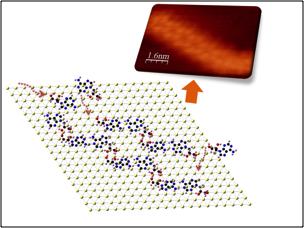
A molecule, called a nucleoside analog and which is composed of an Adenine moeity and glycol group, was deposited on top of the Au(111) surface and studied with scanning tunneling microscopy and density functional theory calculations. The molecule was found to self-assemble into a supramolecular polymer, i.e., a polymer held by hydrogen bonds, that is not only two order of magnitudes longer than any other polymeric structure made by similar molecules on substrates but also encodes a sequence which is erasable with electron-induced excitation. The sequence encoded was the following: glycol-glycol-Adenine-Adenine-glycol-glycol, etc., and it remained intact for hundreds of nanometers. This work suggest that nucleoside polymerization on patterned substrates could be used to create sequence-controlled polymers that store information that is readable and erasable with microscopy techniques. Further, because polymerization takes place on a substrate, theory can be used to design what patterns and what molecules will produce the desired polymeric outcomes.

